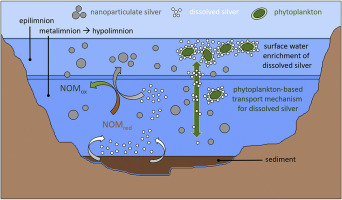Water Research ( IF 12.8 ) Pub Date : 2018-05-10 , DOI: 10.1016/j.watres.2018.05.015 Andreas Wimmer , Anna Kalinnik , Michael Schuster

|
For the first time, the natural formation of silver-based nanoparticles (Ag-b-NPs) was studied in field investigations of two pre-alpine lakes in Germany that contain geogenic silver traces in the sub-ng L−1 range. Apparently, light-sensitive microorganisms most likely accumulate and transport these silver traces from deeper water layers to the surface. At the surface of the eutrophic lake, approximately 40% of total silver (5.7 ng L−1) consisted of Ag-b-NPs, whereas in the oligotrophic lake with similar enrichment of silver species, no Ag-b-NPs were detected. Additional lab experiments with nature-related Ag(I) concentrations in the lower-ng L−1 range and natural organic matter with total organic carbon values of ≤5 mg L−1 revealed that, contrary to common interpretation in the literature, Ag-b-NPs are also or even preferably formed in the dark. Particle size increases gradually with increasing reaction time, showing that Ostwald ripening occurs even at such low particle concentrations. When sulfide ions are present, smaller Ag-b-NPs with a narrower size distribution are formed.
中文翻译:

在自然和半自然条件下形成银基纳米颗粒的新见解
首次在德国的两个前高山湖泊的田野调查中研究了基于银的纳米颗粒(Ag-b-NPs)的天然形成,其中两个湖泊的地质痕迹在ng L -1以下。显然,对光敏感的微生物最有可能积聚这些银迹并将其从更深的水层传输到表面。在富营养化湖的表面,大约40%的总银(5.7 ng L -1)由Ag-b-NP组成,而在富营养化湖中,类似的银物种富集,没有检测到Ag-b-NP。其他与自然相关的Ag(I)浓度在ng L -1以下的浓度和天然有机物的有机碳总值≤5mg L -1的实验室实验揭示了与文献中的通常解释相反,Ag-b-NP也或者甚至优选在黑暗中形成。随着反应时间的增加,粒度逐渐增加,这表明即使在如此低的颗粒浓度下,奥斯特瓦尔德熟化也会发生。当存在硫化物离子时,会形成尺寸分布较窄的较小的Ag-b-NP。



























 京公网安备 11010802027423号
京公网安备 11010802027423号